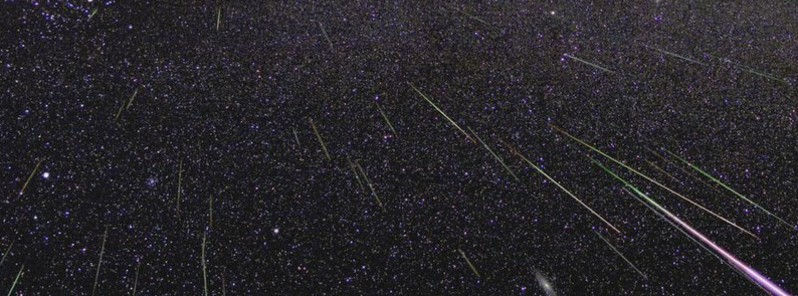Perseids to peak in outburst mode on August 11 and 12, 2016

The Perseid meteor shower is one of the most prolific annual meteor showers and this year it is expected to peak in outburst mode on the night of August 11 and the morning of August 12 (UTC). This means the shower has a great potential to be spectacular, with up to 200 meteors per hour in perfect conditions. Perseids are famous for producing a large number of bright meteors, as well as their occasional outbursts. The last such outburst occurred in 2009.
In most years, Earth might graze the edge of debris left over by the comet 109P/Swift-Tuttle on its 133-year-orbit of the Sun, where there's less activity. This year, however, is one of those years when Jupiter's gravity tugs the huge network of dust trails closer, and our planet plows through closer to the middle of the debris field, where there is more material.
With its nucleus estimated to be about 26 km (16 miles) wide, Swift-Tuttle is the largest object known to repeatedly pass by Earth and experts agree that there are three or more streams on a collision course with Earth this year. The peak rates are predicted to last about half a day, from late August 11 to mid-August 12 UTC.
Forecasters are predicting a Perseid outburst this year with double normal rates. "Under perfect conditions, the rates could soar up to 200 meteors per hour,” said Bill Cooke of NASA’s Meteoroid Environments Office.
As Perseids travel at a speed of 59 km/s (132 000 mph), even a smidgen of dust makes a vivid streak of light when it collides with Earth's atmosphere.
They run each year from July 17 to August 24, so you don't have to wait for the peak night to see them. Waiting for outburst might even ruin your fun, as too-high expectations might not be met. Instead, you can pick any night close to the peak, go to a nice spot away from city lights, allow 30 to 45 minutes for your eyes to adjust to the dark, lie on your back, look up and enjoy the show. The best time to observe them will be between 03:00 and dawn, local time.
The waxing gibbous moon will set shortly after midnight, leaving fairly dark skies for the early morning show. Observing geometry favors Europe at the onset, but increased activity for about half a day means that North America is also well-placed for observations. Observers at southerly latitudes of the southern hemisphere can expect about 60 to 70 meteors per hour. This is still a great show.
Perseids pose no danger to Earth, as most of the meteors burn up about 80 km (50 miles) from the surface. However, an outburst mode usually means trouble for spacecraft.
It is interesting to note that the 1993 Perseid meteor shower outburst is believed to be responsible for the ultimate loss of ESA's telecommunication telescope Olympus-1. In 2009, Landsat-6, an imaging satellite jointly managed by NASA and the USGS, lost gyro stability during the meteor shower's peak.
Comet 109P/Swift-Tuttle last passed nearby Earth in 1992, and the next time will be in 2126.
A live broadcast of the Perseid meteor shower will be available via Ustream overnight on August 11 – 12 and August 12 – 13, beginning at 22:00 EDT (02:00 UTC; UTC is 4 hours ahead of EDT).
Featured image credit: NASA/JPL

Commenting rules and guidelines
We value the thoughts and opinions of our readers and welcome healthy discussions on our website. In order to maintain a respectful and positive community, we ask that all commenters follow these rules.